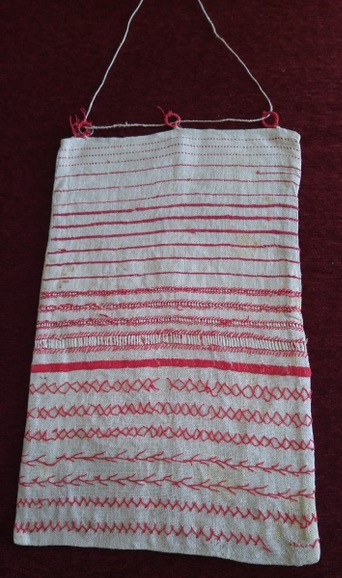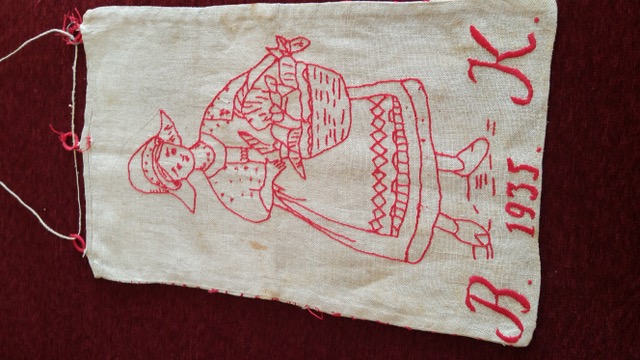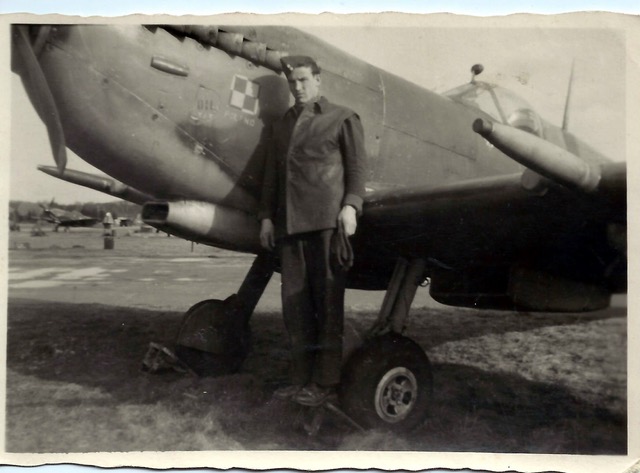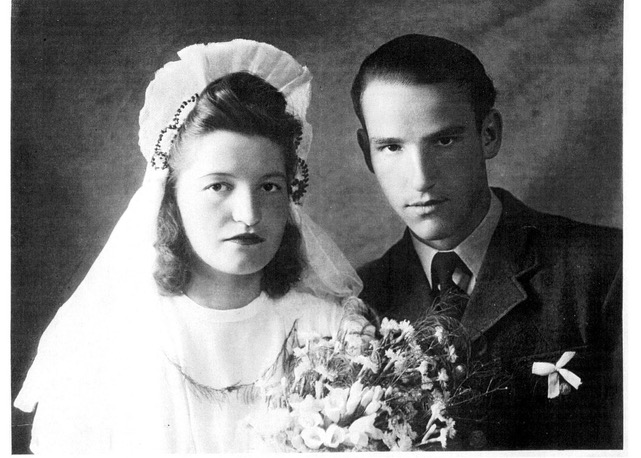Cloth with Red Lines
Christine Haemmerle, Taylor Lenze, and Anna Muller.
Benedykta Jurkiewicz (born Krukowska) was ten years old when she embroidered a white and red cloth that is still in the possession of her family. In 1935, Benedykta lived with her family in Grudziądz. The cloth was a form of training for a young girl practicing her embroidery skills. It is composed of a pattern of varying red lines, the outline of a girl in traditional dress, and the initials of its author – BK. Though not stenciled, the piece combines all the different stiches that she had to learn.

These kinds of cloths were common in many traditional Polish households, usually hanging in the kitchen to create a homey atmosphere that emphasized family values. Benedykta’s father sent it to the US from Poland after the war along with her report cards from school and Christmas ornaments. This was part of who she was. Her new home had to carry the signs of the past.
The beauty of this object beguiles the viewer to the hardships to come. In 1941, sixteen year old Benedykta was taken in a round-up. She spent the remaining years of the war as a forced laborer on a farm in Germany. It was hard to be away from the family, but Benedykta remembers that the family that took her in treated her well, as they considered her to be a good worker.

The end of the war gave her a chance to renew contact with her family. She received the first letter from her father on the German farm on October 5, 1945.A man at the local post-office, whom the family remembers as Pan Lubomski, assisted them. “Mr. Lubomski knew how to get letters out of Poland, like the underground or black market,” Christine Haemmerle, Benedykta's daughter explains. Some letters got to her, some never did or were returned. The first letters, written in small, elegant cursive, contain joy over surviving the war and sorrow over the desolation the war left behind: “The war destroyed all of us terribly.”[1]In endearing expressions, he encourages his daughter, whom he calls beloved (Kochana), not to give up hope in the coming months and tells her that many Poles were returning home.[2]However, Christine learned that her grandfather wanted her mother to begin a new life in America. This was where she had more opportunities. He did not realize that he would never see her again. Itwas not until 25 years later that they went to visit her relatives -- aunts, uncles, cousins, in-laws, etc. Her parents had died by then.

While still in Germany, in 1946 she met Bolesław Jurkiewicz, who served in the Polish branch of the Royal British Air Force. They married in Germany. Their children, Krystyna and her brother Czesław, were both born in England, where their father was then stationed.“In 1951 we came to America via the Queen Mary,” Haemmerle writes, where the family eventually settled. She still has the original passenger list from the trip. “I have a very rich history and many pictures and artifacts that belong to my parents. I am a very proud Polish-American. We always spoke Polish at home but loved our new country, America and all it stood for. No American was more patriotic than my Tata. In 1963 we became American citizens!” Soon after, Krystyna changed her name to Christine.Fully American, the family never forgot its Polish roots. But Benedykta passed away on Christmas Day, 2013. Boleslaw passed away 7 weeks later on February 16, 2014.Benedykta's embroidered cloth remains as tangible evidence for coming generations of their Polish past.

[1]Polish: "Wojna nas wszystkich ogromnie zniszczyła.”
[2]Kochana córuś pragnęlibyśmy cię tak okrutnie mieć w domy jednak Bóg tak chciał, że musisz być tak daleko od nas więc musimy się z tem pogodzić może też nie długo powrócisz. Gazeta pisała, że od listopada będzie 7 do 8 tys. Dziennie Polaków z Niemiec wyjeżdżać, może tez na ciebie niedługo kolej przyjdzie, sama nie puszczaj się drogą odczekaj transportu nawet trochę później, ale pewniej.